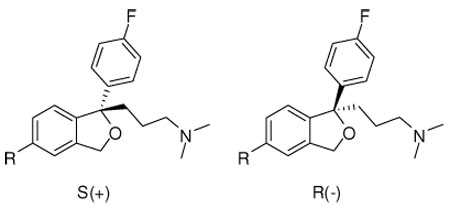Table 2.
In Vitro Data for (±)1 and its chiral analoguesa
 | ||||||
|---|---|---|---|---|---|---|
| compound | R’ | SERT Ki ± SEM (nM) |
NET Ki ± SEM (nM) |
DAT Ki ± SEM (nM) |
Ki(NET)/Ki (SERT) |
Ki(DAT)/Ki (SERT) |
| (±)-1 | CN | 1.94 ± 0.198 | 5950 ± 77.4 | 9270 ± 872 | 3070 | 4780 |
| S(+)-1 | CN | 0.89 ± 0.132 | 10500 ± 893 | 8150 ± 314 | 11800 | 9160 |
| R(−)-1 | CN | 28.3 ± 3.62 | 4980 ± 515 | 7980±646 | 178 | 282 |
| (±)-5b | Br | 1.04 ± 0.126 | 28400 (global fit no SEM) |
1650 ± 112 | >10,000 | 1590 |
| S(+)-5 | Br | 0.92 ± 0.056 | 8410 ± 202 | 2250 ± 115 | 9140 | 2450 |
| R(−)-5 | Br | 23.6 ± 1.76 | 21600 ± 3210 | 1350 ± 44 | 915 | 57 |
| (±)-9 | Ph-CH=CH | 9.32 ± 1.36 | 11400 ± 1090 | 836 ± 14.9 | 1220 | 90 |
| S(+)-9 | Ph-CH=CH | 10.6 ± 1.09 | 16800 ± 1360 | 1810 ± 46.8 | 1590 | 171 |
| R(−)-9 | Ph-CH=CH | 113 ± 14.7 | 5190 ± 427 | 541 ± 40.7 | 46 | 4.79 |
